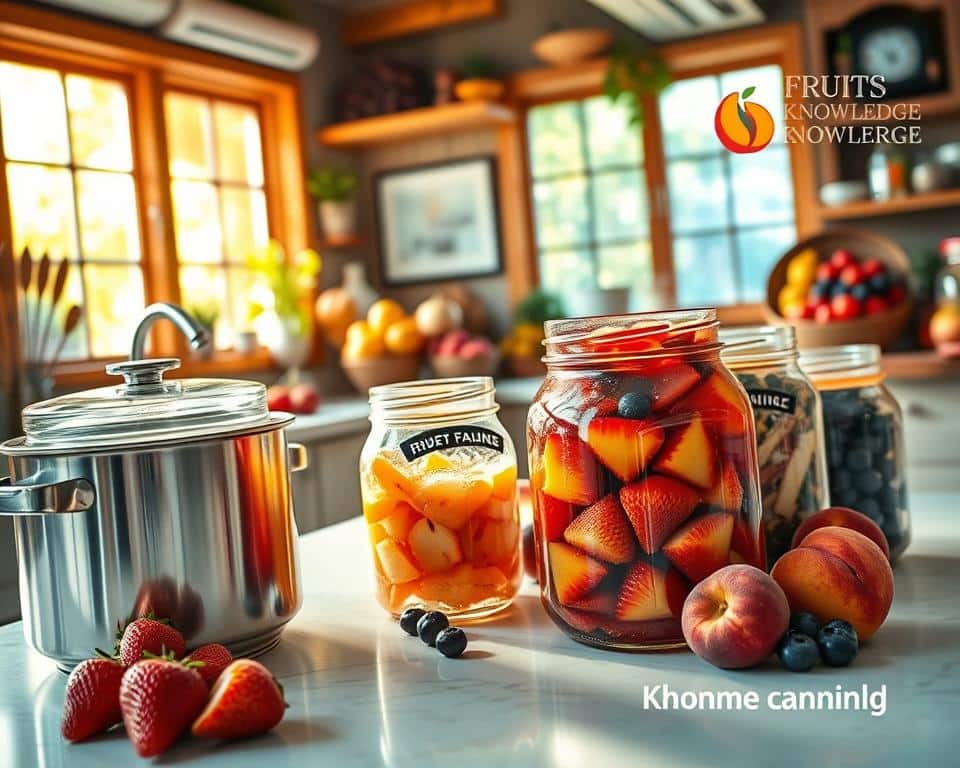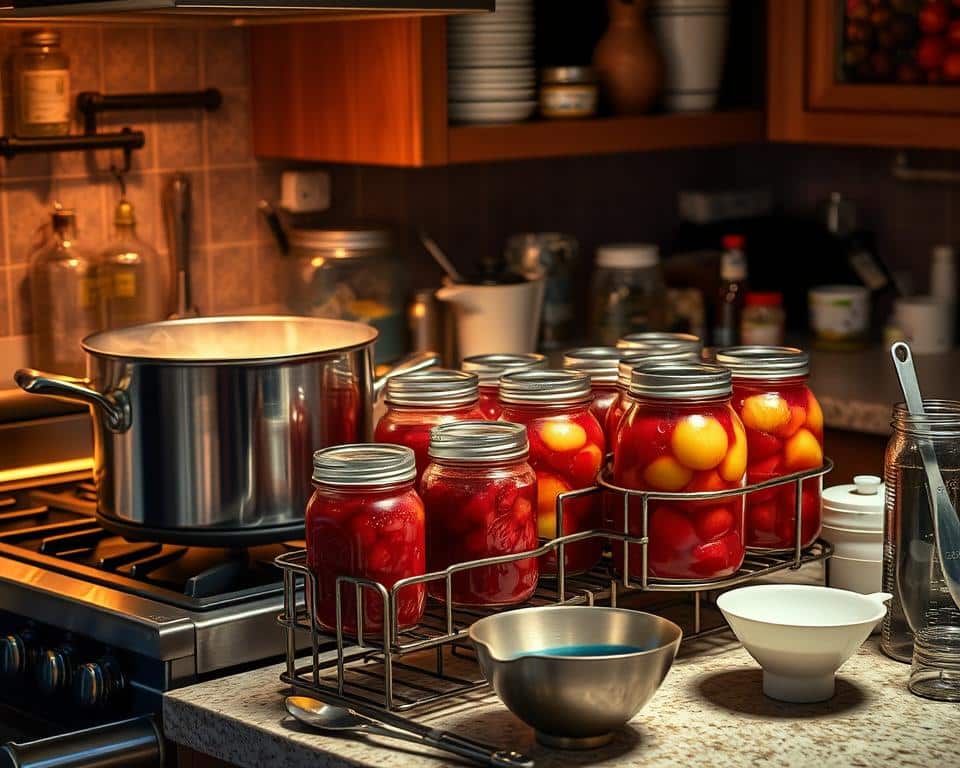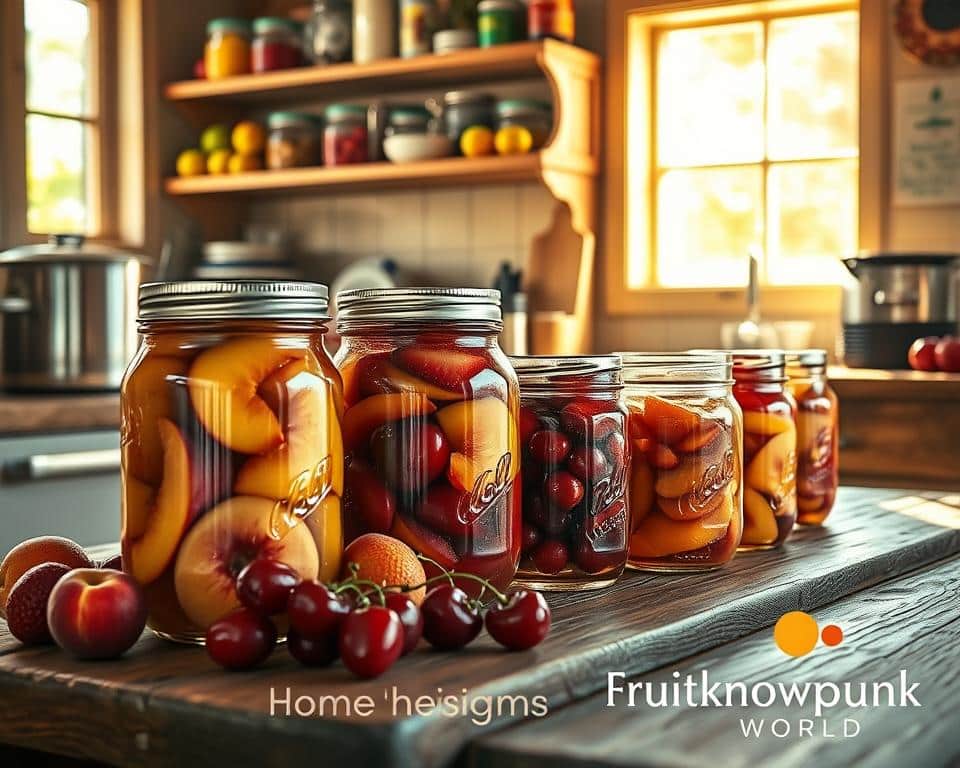Welcome to your guide on home canning. This will help you keep fresh fruits longer. With simple canning steps and key tools, you can easily make your own preserved fruit at home. Enjoy the taste of summer fruits any time of the year!
Water bath canning is a basic way to preserve high-acid fruits. You just need to boil jars full of fruit. Ensure you have good jars like Mason or Ball brands, and new lids for a tight seal. Always check if your jars are sealed well to keep fruits fresh longer.
First, get your kitchen and canning tools ready. This includes a canning funnel, a jar lifter, and a water bath canner. It’s important to work fast to avoid air traps and keep the right space in jars. After canning, place your fruits in a dark, cool place. They will stay good for one year, taste great, and keep their nutrients.
Key Takeaways
- Canning keeps fresh fruits good for up to a year.
- A water bath canner works best for high-acid fruits.
- High-quality jars and new lids are crucial for canning success.
- Prepare with essential tools like a funnel and jar lifter beforehand.
- For the best freshness, store canned fruits in a cool, dark spot.
- Make sure your jars are sealed well for proper preservation.
Why Choose Canning for Fresh Fruits?
Canning lets you enjoy fresh fruits all year. It keeps their nutrients. It’s great for saving fruits affordably.

Benefits of Canning
Home canning keeps summer’s taste alive. You can eat fresh fruits any time. It cuts down on waste. Sharon Palmer says it connects us to old cooking ways. It lets families enjoy seasonal fruits all year.
Preservation of Nutrients
Canning fruits right after picking keeps their vitamins and minerals. Michigan State University’s study shows canned fruits are as nutritious as fresh or frozen ones. It’s a smart way to eat healthy.
Cost-Effective Solution
Canning saves money over time. The start-up cost is low. Buying in bulk and canning stretches your budget. You’ll have lots of healthy food options. This makes canning a smart choice for those watching their spending.
- Pre-treat apples, apricots, and pears with ascorbic acid to prevent darkening.
- Use standard Mason jars due to their heat-tempered material and proper sealing surfaces.
- Follow manufacturer’s instructions for treating lids to maintain safety.
- Carefully place hot jars on dry towels or cooling racks to prevent breakage.
- Boiling water bath canning is suitable for high-acid fruits.
By canning at home, you support sustainable eating all year long. You get tasty, nourishing fruits no matter the season.
Essential Tools and Equipment for Fruit Canning
Starting your fruit canning journey? You’ll need a collection of essential tools and equipment. A complete canning supply checklist is key. It ensures you have everything needed to preserve your fresh harvest. Whether you’re new or experienced in canning, the right equipment makes the process easier and safer. Let’s explore the basic kitchen tools, canning-specific items, and how to select the best jars for canning fruits.
Basic Kitchen Tools
First, gather the basic kitchen tools. These are crucial for preparing your fruits.
- Durable cutting boards and knives, like those from Rada, are great for chopping and slicing fruits.
- A ladle and the Vidalia Chop Wizard help in dicing and filling jars neatly.
- Use a food mill or Victorio Strainer to remove skins and seeds for juices and sauces.
- Liquid measuring cups ensure your canning recipes are safe and precise.
- Wooden chopsticks or skewers help eliminate air bubbles for a better seal in jars.
Canning Specific Tools
Now, let’s talk about canning-specific tools. These items are must-haves:
- A boiling water bath canner is needed for high-acid foods like fruits and jellies.
- For low-acid foods like vegetables, a pressure canner is essential to prevent botulism.
- Jar lifters allow for safe removal of hot jars from the canner.
- A funnel makes transferring liquids into jars mess-free.
- A canning rack keeps jars from touching the canner’s bottom.
- Use bubble popper tools to remove air bubbles and ensure a solid seal.
- Headspace measuring tools help you keep the right air space in your jars.
- Lid racks are handy for sterilizing lids effectively.
Choosing the Right Jars
Choosing the right jars is crucial for canning success. Consider the following:
- Ball and Kerr mason jars are top choices for their strong seals and durability.
- Jars vary in sizes from half-pints to half-gallons. They come with regular or wide mouths.
- Regular mouth jars suit fluid foods well. Wide mouth jars are ideal for larger items.
- Canning lids, like those from Ball, have a thin metal lid with a rubber seal for sealing.
- Use jar bands to keep the lid in place during canning, ensuring a tight seal.
With these tools and equipment, you’re set to start preserving your fruits. Happy canning!
Getting Started with Water Bath Canning
Water bath canning is great for keeping high-acid foods like fruits, tomatoes, and pickles safe for a long time. You’ll learn how to can properly, why you need to sterilize jars, and how to steer clear of common mistakes.

Step-by-Step Process
Starting to can is simpler than it seems. Just follow these steps:
- Prepare the Canner: Put enough water in your canning pot. It should cover the jars by at least an inch.
- Sterilize Jars: You need to boil jars for 10 minutes to clean them, especially if your recipe is quick.
- Prepare the Food: Warm up your fruits or other high-acid ingredients according to your recipe.
- Fill Jars: Put the hot food in your clean jars, leaving the right amount of space at the top.
- Remove Air Bubbles: Tap the jar or use a spatula to get rid of air pockets.
- Seal Jars: Clean the jar rim for a perfect seal. Put the lid on and screw the band on lightly.
- Process Jars: Use a jar lifter to put jars into boiling water. The time they need to boil varies.
Tips for Sterilizing Jars
Properly sterilizing jars is key to safe canned goods. Here’s how:
- Boil jars for 10 minutes to kill off germs.
- Always use new lids for a tight seal.
- Keep jars clean by handling them with dry hands.
- Make sure jars are completely underwater when boiling.
Common Mistakes to Avoid
A beginner’s guide to canning includes avoiding pitfalls. Keep these pointers in mind:
- Incorrect Headspace: Not leaving the right amount of space can mess up the sealing.
- Insufficient Processing Time: For high places, you’ll need to add more boiling time.
- Dirty Jar Rims: Food on the rim can lead to bad seals and contamination.
- False Seals: Don’t store jars with the bands on. Check seals after a day.
By following these guidelines, you can dodge common errors and enjoy your preserved fruits for a long time.
| Altitude (feet) | Processing Time Increase |
|---|---|
| 1,001 to 3,000 | 5 minutes |
| 3,001 to 6,000 | 10 minutes |
| 6,001 to 8,000 | 15 minutes |
| 8,001 to 10,000 | 20 minutes |
How to Prepare Fruits for Canning
When you’re preparing fruit for canning, start with the best fruit. Look for fruits without damage or mold. Stay away from fruits that are too ripe. They can mess up the final product’s texture and flavor. We’ll show you the right canning prep techniques to keep your fruit fresh.
First, wash the fruits well. Make a wash with 1 cup of distilled white vinegar and 1 gallon of water. This mix removes bacteria and dirt from the fruit.
Blanching is crucial, especially for fruits like peaches or tomatoes. First, score them lightly. Then boil them for 40 to 60 seconds and put them in cold water. This makes peeling easy and keeps the fruit in good shape.
Now, cut and slice the fruit as your recipe requires. Be careful to keep their shape. Use tools like apple corers and paring knives for better results.
To stop fruits like apples from browning, use a citric acid bath. Mix ½ cup of lemon juice with 8 cups of water. You could also use 3,000 mg of Vitamin C tablets per 1 gallon of water instead.
Finally, pack the fruit into jars, leaving a ¾” gap at the top. This space is needed for expansion. Put the jars in a canning pot with water covering them by at least ½”. Follow the recipe for processing times.
| Step | Details |
|---|---|
| 1. Quality Selection | Choose highest-quality fruits; avoid over-ripe or damaged ones. |
| 2. Washing | Use a vinegar and water mixture for effective cleaning. |
| 3. Blanching | Score, then blanch in boiling water for 40-60 seconds. |
| 4. Cut/Slice | Core, chop, or slice using proper tools as per recipe. |
| 5. Anti-Browning | Use citric acid or Vitamin C solution to prevent browning. |
Following these canning prep techniques helps you keep fruits fresh and tasty for a long time. Remember to sign up for our newsletter for more canning tips and recipes!
Hot Pack vs. Cold Pack: Understanding the Methods
Choosing the right canning technique is important. It depends on the type of fruit and what you want as a result. Both hot pack and cold pack methods have their own benefits. We’ll explore both to help you decide for your next canning project.
Hot Pack Method
Hot pack canning means you cook fruits before putting them in jars. It’s great for peaches, pears, and tomatoes. You usually blanch the fruits to peel them easily, then simmer in syrup or their juices. This step removes air bubbles and ensures a tight pack. As a result, the flavor and color last longer.
Following the USDA, hot packing reduces food floating in jars. It also cuts down on the jars you need. This makes it an efficient and effective choice.
Cold Pack Method
Cold pack preservation is about putting raw fruits directly into jars. Then, you cover them with boiling liquid. This method is faster and keeps the fruit’s texture better. However, it might leave more air bubbles and be less efficient for storage. The National Center for Home Food Preservation suggests raw pack for veggies to be pressure canned. But be careful, it might cause floating fruit and color changes over time.
Which Method to Choose?
Choosing between hot pack and cold pack canning? It depends on your fruit and storage goals. Hot pack is better for long-term storage. It removes more air, keeping the color and flavor fresh. Cold pack, however, is great for keeping the texture of your produce. Try both to see what works best for you. Always use reliable sources like the USDA’s guidelines for safe and tasty results.



